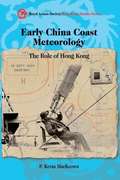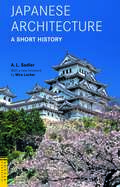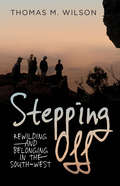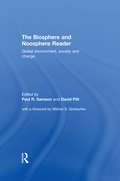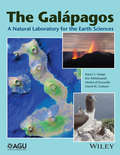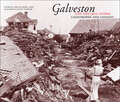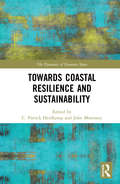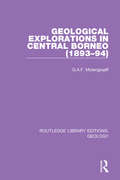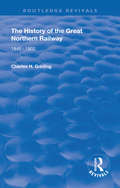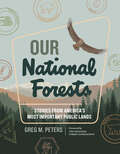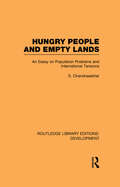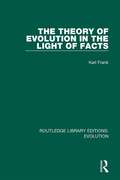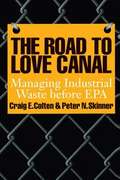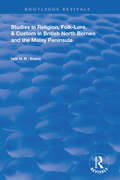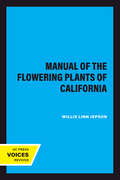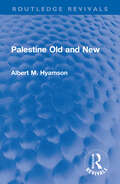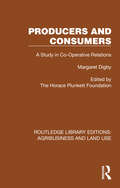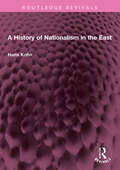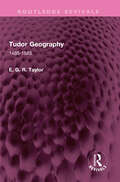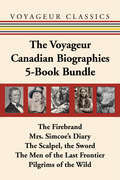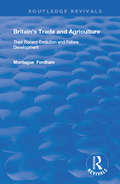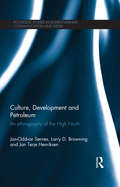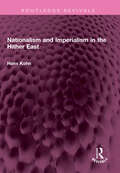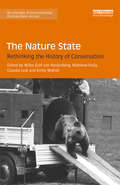- Table View
- List View
Early China Coast Meteorology
by P. Kevin MackeownIn this colourful story of the Hong Kong Observatory, P. Kevin MacKeown takes us through the dev
Japanese Architecture: A Short History
by A. L. Sadler Mira LocherA. L. Sadler's invaluable study of Japanese architecture first appeared in 1941. Considered a classic in its field, unequaled in clarity and insight, Japanese Architecture A Short History is a lucid and uncomplicated introduction to this important aspect of Japanese culture. Beginning with the earliest evidences from prehistory and ending with the Edo period, when Japan attained stature as a modern state, Japanese Architecture is as relevant today as it was in 1941.
Stepping Off: Rewilding and Belonging in the South-West
by Thomas WilsonStepping Off is a book for locals and travellers alike. It is the story of the south-western corner of Western Australia: an environmental history, a social history, an invitation to reconnect with the land – and in doing so, to reconnect with ourselves.
The Biosphere and Noosphere Reader: Global Environment, Society and Change
by Paul R. Samson David PittThe Reader is the first comprehensive history of the noosphere and biosphere. Drawing on classical influences, modern parallels, and insights into the future, the Reader traces the emergence of noosphere and biosphere concepts within the concept of environmental change. Reproducing material from seminla works, both past and present, key ideas and writings of prominent thinkers are presented, including Bergson, Vernadsky, Lovelock, Russell, Needham, Huxley, Medawar, Toynbee and Boulding, and extensive introductory pieces bu the editors drawattention to common themes and competing ideas. Focussing on issues of origins, theories, parallels and potential, the discussions place issues in a broad context, compare and contrast central concepts with those of the Gaia hypothesis, sustainability and global change, and examine the potential application of noospheric ideas to current debates about culture, education and technology in such realms as the Internet, space exploration, and the emergence of super-consciousness. Literally the `sphere of mind or intellect', the noosphere is aprt of the `realm of the possible' in human affairs, where there is a conscious effort to tackle global issues The noosphere concept captures a number of key contemporary issues - social evolution, global ecology, Gaia, deep ecology and global environmental change - contributing to ongoing debates concerning the implications of emerging technologies.
The Galapagos: A Natural Laboratory for the Earth Sciences
by Karen S. Harpp Noémi D'Ozouville Eric Mittelstaedt David W. GrahamThe Galápagos Islands are renown for their unique flora and fauna, inspiring Charles Darwin in the elaboration of his theory of evolution. Yet in his Voyage of the Beagle, published in 1839, Darwin also remarked on the fascinating geology and volcanic origin of these enchanted Islands. Since then, the Galápagos continue to provide scientists with inspiration and invaluable information about ocean island formation and evolution, mantle plumes, and the deep Earth.Motivated by an interdisciplinary Chapman Conference held in the Islands, this AGU volume provides cross-disciplinary collection of recent research into the origin and nature of ocean islands, from their deepest roots in Earth's mantle, to volcanism, surface processes, and the interface between geology and biodiversity.Volume highlights include:Case studies in biogeographical, hydrological, and chronological perspectiveUnderstanding the connection between geological processes and biodiversitySynthesis of decades of interdisciplinary research in physical processes from surface to deep interior of the earthIn-depth discussion of the concept of the island acting as a natural laboratory for earth scientistsIntegrated understanding of the Galápagos region from a geological perspectiveCollectively, The Galápagos presents case studies illustrating the Galápagos Archipelago as a dynamic natural laboratory for the earth sciences. This book would be of special interest to a multidisciplinary audience in earth sciences, including petrologists, volcanologists, geochronologists, geochemists, and geobiologists.
Galveston and the 1900 Storm: Catastrophe and Catalyst
by Patricia Bellis Bixel Elizabeth Hayes TurnerThe Galveston storm of 1900 reduced a cosmopolitan and economically vibrant city to a wreckage-strewn wasteland where survivors struggled without shelter, power, potable water, or even the means to summon help. At least 6,000 of the city's 38,000 residents died in the hurricane. Many observers predicted that Galveston would never recover and urged that the island be abandoned. Instead, the citizens of Galveston seized the opportunity, not just to rebuild, but to reinvent the city in a thoughtful, intentional way that reformed its government, gave women a larger role in its public life, and made it less vulnerable to future storms and flooding. This extensively illustrated history tells the full story of the 1900 Storm and its long-term effects. The authors draw on survivors' accounts to vividly recreate the storm and its aftermath. They describe the work of local relief agencies, aided by Clara Barton and the American Red Cross, and show how their short-term efforts grew into lasting reforms. At the same time, the authors reveal that not all Galvestonians benefited from the city's rebirth, as African Americans found themselves increasingly shut out from civic participation by Jim Crow segregation laws. As the centennial of the 1900 Storm prompts remembrance and reassessment, this complete account will be essential and fascinating reading for all who seek to understand Galveston's destruction and rebirth.
Towards Coastal Resilience and Sustainability (The Dynamics of Economic Space)
by C. Patrick Heidkamp John MorrisseyCoastal zones represent a frontline in the battle for sustainability, as coastal communities face unprecedented economic challenges. Coastal ecosystems are subject to overuse, loss of resilience and increased vulnerability. This book aims to interrogate the multi- scalar complexities in creating a more sustainable coastal zone. Sustainability transitions are geographical processes, which happen in situated, particular places. However, much contemporary discussion of transition is either aspatial or based on implicit assumptions about spatial homogeneity. This book addresses these limitations through an examination of socio- technological transitions with an explicitly spatial focus in the context of the coastal zone. The book begins by focusing on theoretical understandings of transition processes specific to the coastal zone and includes detailed empirical case studies. The second half of the book appraises governance initiatives in coastal zones and their efficacy. The authors conclude with an implicit theme of social and environmental justice in coastal sustainability transitions. Research will be of interest to practitioners, academics and decision- makers active in the sphere of coastal sustainability. The multi- disciplinary nature encourages accessibility for individuals working in the fields of Economic Geography, Regional Development, Public Policy and Planning, Environmental Studies, Social Geography and Sociology.
Geological Explorations in Central Borneo (Routledge Library Editions: Geology #11)
by G.A.F. MolengraaffThis book, first published in 1902, is the product of the detailed geological survey undertaken by the Borneo Expedition of the late nineteenth century. The scientific exploration focused on Central Borneo, especially the sources of the Kapoewas and its tributaries, and its analysis of the geology of the region still today forms the bedrock of research into the area.
The History of The Great Northern Railway: 1845 - 1902 (Routledge Revivals)
by Charles H. GrinlingPublished in 1903, this book provides a complete account of the origin and development of the Great Northern Railway Company from its inception to the year 1802, a period of around 60 years.
Our National Forests: Stories from America's Most Important Public Lands
by Greg M. PetersStories from America&’s Most Important Public Lands Across 193 million acres of forests, mountains, deserts, watersheds, and grasslands, national forests provide a multitude of uses as diverse as America itself. Welcoming 170 million visitors each year to hike, bike, paddle, ski, fish, and hunt, &“the people&’s lands&” offer more than just recreation. Timber is harvested, lost habitats are recovered, and endangered wildlife is protected as part of the Forest Service&’s enduring mission. In Our National Forests, Greg Peters reveals an inside look at America&’s most important public land and the people committed to protecting it and ensuring access for all. From the story of how the Forest Service grows millions of seedlings in the West each year, to their efforts to save the hellbender salamander in Appalachia, the narrative spans the breadth of the country and its diverse ecology. People are at the center of the stories, whether the dedicated folks in the Forest Service, or the everyday citizens who support and tend to the protected lands near their homes. This complete look at America&’s National Forests—their triumphs, challenges, controversies, and vital programs—is a must-read for everyone interested in the history of America's most important public lands.
Hungry People and Empty Lands: An Essay on Population Problems and International Tensions (Routledge Library Editions: Development)
by S. ChandrasekharFirst published in 1954, this reissue deals with the problem of international tensions arising from demographic and fertility differences, with special reference to such heavily populated Asian countries as China, Japan and India.
The Theory of Evolution in the Light of Facts (Routledge Library Editions: Evolution #3)
by Charles T. DrueryOriginally published in 1913, The Theory of Evolution in the Light of Facts examines the theory of Descent; the book is a time capsule of information, providing a record of the explorations into Darwinian theory during the first half of the 20th century. The book examines the contradictions which arose between technical work of the period and the assumptions surrounding the theory of evolution. The book aims to address that which is considered ‘certain’ or ‘probable’ from postulation in order to explain and clearly define the theory of evolution. It does this through hypothesising on the development of animals and plants using the systems of Darwin and Lamarck. This book will be of interest to anthropologists and historians of natural science alike.
The Road to Love Canal
by Craig E. Colten Bruce Piasecki Peter N. SkinnerThe toxic legacy of Love Canal vividly brought the crisis in industrial waste disposal to public awareness across the United States and led to the passage of the Superfund legislation in 1980. To discover why disasters like Love Canal have occurred and whether they could have been averted with knowledge available to waste managers of the time, this book examines industrial waste disposal before the formation of the Environmental Protection Agency in 1970. Colten and Skinner build their study around three key questions. First, what was known before 1970 about the hazards of certain industrial wastes and their potential for causing public health problems? Second, what were the technical capabilities for treating or containing wastes during that time? And third, what factors other than technical knowledge guided the actions of waste managers before the enactment of explicit federal laws? The authors find that significant information about the hazards of industrial wastes existed before 1970. Their explanations of why this knowledge did not prevent the toxic legacy now facing us will be essential reading for environmental historians and lawyers, public health personnel, and concerned citizens.
Studies in Religion, Folk-Lore, and Custom in British North Borneo and the Malay Peninsula (Routledge Revivals)
by Ivor H. EvansOriginally published in 1923, the following papers contain the results of investigations concerning religion and custom in Borneo and the Malay Peninsula, which were carried out at intervals during the years 1910 to 1921 by the author. It includes chapters on the customs and beliefs of the 'Orangdusun', beliefs and customs of the Sakai, and Malay folk-tales.
A Manual of the Flowering Plants of California
by Willis Linn JepsonThis title is part of UC Press's Voices Revived program, which commemorates University of California Press’s mission to seek out and cultivate the brightest minds and give them voice, reach, and impact. Drawing on a backlist dating to 1893, Voices Revived makes high-quality, peer-reviewed scholarship accessible once again using print-on-demand technology. This title was originally published in 1925.
Bird Girl: Gene Stratton-Porter Shares Her Love of Nature with the World
by Jill EsbaumThis lively STEAM picture book is about the life of Gene Stratton-Porter, a pioneering wildlife photographer and popular author from the late 19th and early 20th century, who showed the world the beauty of nature, especially birds, and why it was worth preserving.Gene Stratton-Porter was a farm girl who fell in love with birds, from the chickens whose eggs she collected to the hawks that preyed on them. When she grew up, Gene wanted nothing more than to share her love of birds with the world. She wrote stories about birds, but when a magazine wanted to publish them next to awkward photos of stuffed birds, she knew she had to take matters into her own hands. Teaching herself photography, Gene began to take photos of birds in the wild. Her knowledge of birds and how to approach them allowed her to get so close you could count the feathers of the birds in her photos. Her work was unlike anything Americans had ever seen before—she captured the true lives of animals in their natural habitat. A pioneering wildlife photographer and one of the most popular authors of the early 20th century, this bird girl showed the world the beauty of nature and why it was worth preserving.
Palestine Old and New (Routledge Revivals)
by Albert M. HyamsonFirst published in 1928, Palestine Old and New is a historical travel guide providing a preliminary account of Palestine through the eye of a Zionist. The book takes the reader through the natural landscape of Palestine, familiarizing them with the local Muslim, Jewish and Christian populations, and providing both historical and Biblical accounts of various sites. As the chief immigration officer in British Mandate of Palestine from 1921 to 1934, the intended audience of the author was the Jews thinking about immigrating to Palestine, but his descriptive portrayal of the currently occupied territory is a rich account for present readers of the Palestine that was. The language used is a reflection of its era and no offence is meant by the Publishers to any reader by this republication. This book will be of interest to students of history, political science, international relations and geography.
Producers and Consumers: A Study in Co-Operative Relations (Routledge Library Editions: Agribusiness and Land Use #6)
by Margaret DigbyAlthough originally published in 1928, many of the issues discussed in this book remain pertinent today: in unstable markets grappling with labour shortages, how to pay the producers of food a fair price, at a price the consumer can afford, whilst maximising efficiency and minimising waste. Against this backdrop, the book discusses co-operative movements from the UK, Denmark, New Zealand, the former USSR and the USA.
A History of Nationalism in the East (Routledge Revivals)
by Hans KohnFirst published in 1929, A History of Nationalism in the East brings together in one truly fascinating volume a mass of information hitherto scattered and partly unavailable. Hans Kohn sums up the general situation in his Introduction. He tells us that the World War I produced three great communities of interest, distinct and, to some extent, mutually antagonistic. The first was that of the continent of Europe, barring Russia, which was faced with the necessity for the gradual breaking down of national boundaries, for political, financial, and economic reasons. The second was that of the Anglo-Saxon people, the United States, Great Britain, Canada, Australia, and South Africa. This had to face Soviet Russia on the one hand, and the Oriental, the third, community of interests on the other. Here he sketches suggestively the development of the nationalist movement in Islam, India, Egypt, Turkey, Arabia, and Persia. The language used is a reflection of its era and no offence is meant by the Publishers to any reader by this republication. This book will be of interest to students of history, political science, international relations, and geography.
Tudor Geography: 1485-1583 (Routledge Revivals)
by E. G. TaylorFirst published in 1930, Tudor Geography discusses the men and the geographical concepts that enabled world-famous voyages by the British with the aim of circumventing Spanish and Portuguese monopoly of the direct routes to the Spice Islands. The book throws light on a new facet of a fateful century during which Englishmen of all ranks were forced gradually, by circumstances, to think geographically as they had never done before. This book will be of interest to students of history and geography.
The Voyageur Canadian Biographies 5-Book Bundle: The Firebrand / Mrs. Simcoe's Diary / The Scalpel, the Sword / The Men of the Last Frontier / Pilgrims of the Wild
by Grey Owl James Polk Michael Gnarowski Hugh Eayrs Julie Allan Norman Bethune Allan Susan Ostrovsky Sydney Gordon Mary Quayle Innis Elizabeth Posthuma Simcoe William Kilbourn Ronald StaggVoyageur Classics is a series of special versions of Canadian classics, with added material and new introductory notes. In this bundle we find five biographical and autobiographical titles that shed light on some of Canada’s most important figures at crucial times in the country’s development. William Kilbourn brings to life the rebel Canadian hero William Lyon Mackenzie: able political editor, first mayor of Toronto, and the gadfly of the House of Assembly. The Scalpel, the Sword celebrates the turbulent career of Dr. Norman Bethune, a brilliant surgeon, campaigner for socialized medicine, and communist. Elizabeth Simcoe’s diary, describing Canada from 1791 to 1796, is history written as it was being made, an account instilled with excitement and delight. And finally, two titles by the legendary Grey Owl tell his own astonishing story and advocate for a closeness with and respect for nature. Each of these books is an essential classic of Canadian literature. Includes The Firebrand Mrs. Simcoe’s Diary The Scalpel, the Sword The Men of the Last Frontier Pilgrims of the Wild
Britain's Trade and Agriculture: Their Recent Evolution and Future Development (Routledge Revivals)
by Montague FordhamPublished in 1932: The author in his Britain's Trade and Agriculture, though almost ruthlessly exposes the fallacies that lie behind the modern accepted views on industry and agriculture, though he obviously writes without desire to attract attention, but simply to clarify facts and to suggest practical solutions.
Culture, Development and Petroleum: An Ethnography of the High North (Routledge Studies in Environmental Communication and Media)
by Jan-Oddvar Sornes Larry Browning Jan Terje HenriksenThe discovery, just forty years ago, of vast oil and gas reserves in the Southwestern part of Norway, and more recently in the Arctic High North region, created an economic titan and posed a vast array of challenges for both the Norwegian government and the residents of this area. How to extract and transport all that oil and gas without despoiling the pristine environment? How to use this wealth in a socially responsible and sustainable way? How to prepare the rural High North citizens—traditionally fishermen and farmers—for a global, high-tech economy? Adopting an original narrative approach to qualitative research, this book tells the stories of 21 individuals either living or having a genuine interest in the High North, from mayors and entrepreneurs to farmers and fishermen. Through these first-hand meetings, it constructs an ethnographic study that reveals how petroleum and development have impacted on the regional economy and culture. This book will be of interest to all stakeholders in the oil and gas industry, and for students and scholars of organization studies, cultural and communication studies, environmental anthropology, natural resource management and sustainable development.
Nationalism and Imperialism in the Hither East (Routledge Revivals)
by Hans KohnFirst published in 1932, Nationalism and Imperialism in the Hither East seeks to present the history of Turkey, Egypt and Arabia in the decade where the political structures created by World War I and the Peace Conferences sought consolidation and the evolution of their own life. The story begins where, after the immediate consequences of the War had been liquidated, the civil and political administration of the several countries was established. This book is intended as contribution to the endeavour to understand the historical and sociological character of nationalism and of the forces which are determining the history of our own day. The social, political, and cultural movements in these countries, the struggle between imperialism and nationalism throw light upon the processes which extend far beyond the region under consideration. The language used is a reflection of its era and no offence is meant by the Publishers to any reader by this republication. This book will be of interest to students of history, political science, international relations, and geography.
The Nature State: Rethinking the History of Conservation (Routledge Environmental Humanities)
by Wilko Graf Hardenberg Matthew Kelly Claudia Leal Emily WakildThis volume brings together case studies from around the globe (including China, Latin America, the Philippines, Namibia, India and Europe) to explore the history of nature conservation in the twentieth century. It seeks to highlight the state, a central actor in these efforts, which is often taken for granted, and establishes a novel concept – the nature state – as a means for exploring the historical formation of that portion of the state dedicated to managing and protecting nature. Following the Industrial Revolution and post-war exponential increase in human population and consumption, conservation in myriad forms has been one particularly visible way in which the government and its agencies have tried to control, manage or produce nature for reasons other than raw exploitation. Using an interdisciplinary approach and including case studies from across the globe, this edited collection brings together geographers, sociologists, anthropologists and historians in order to examine the degree to which sociopolitical regimes facilitate and shape the emergence and development of nature states. This innovative work marks an early intervention in the tentative turn towards the state in environmental history and will be of great interest to students and practitioners of environmental history, social anthropology and conservation studies.
